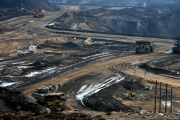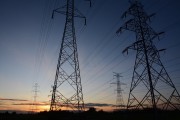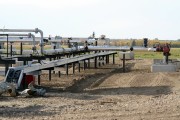In a landmark speech on climate change yesterday, U.S. President Barack Obama said that the climate impact of the Keystone XL pipeline proposal “will be absolutely critical” to his decision on its fate.
In the hours since, it’s been a fascinating — and revealing — exercise to read the responses his words have provoked. Some supporters saw a green light for Keystone, while opponents called it a “death knell.” So let’s take a minute to peer deep into the inkblot and assess the signal Obama sent, what this pipeline really means for the climate and what Canada needs to do now.
As others have pointed out, supporters of the pipeline tend make their case on economic benefits, construction jobs and Canada’s status as a good neighbour.
So Obama’s decision to include Keystone in a climate speech in the first place — making a crystal-clear link between pipelines and greenhouse gas pollution — is a signal that may matter more than the specific words he used.
In our view, the President is absolutely right: the current pipeline debate is, more than anything else, a debate about climate change. Greenhouse gas pollution is the reason many of us started paying attention to pipelines in the first place. So we were heartened by Obama’s words, seeing them as a measured and appropriate way to make decisions about new fossil-fuel infrastructure.
Building Keystone would open up the spigot for oilsands production. It’s like asking whether building a new highway to a suburban NHL arena would result in more people driving to hockey games.
The test Obama has set for determining whether Keystone is in the U.S.’s national interest is whether the pipeline will “significantly exacerbate the problem of carbon pollution.” It’s worth noting that he’s not just talking about greenhouse gas emissions in the U.S. — it’s the project’s “net effects” on the climate that matter.
So would the pipeline increase emissions? Of course it would.
Oil from Alberta’s oilsands produces more greenhouse gas pollution than the average barrel of crude refined in the U.S. Building Keystone would open up the spigot for oilsands production. It’s like asking whether building a new highway to a suburban NHL arena would result in more people driving to hockey games.
Right now, companies in the oilsands are nervous about getting their product to market. Existing pipelines are filling up and the prospects for building new pipelines through British Columbia are uncertain, to say the least. Rail is still a niche option that costs twice as much (or more) as transportation by pipeline.
Put yourself in the companies’ shoes: would you feel more confident making the multi-billion dollar investment to build a new oilsands facility with Keystone, or without it?
Pembina’s analysis found that building the Keystone pipeline would enable a 36 per cent increase in oilsands production from current levels. The emissions associated with that production are equivalent to the annual emissions of adding over 4 million new cars to the road (or to use a comparison that’s relevant to Obama’s speech yesterday, to six new coal plants). And that’s just from the Canadian side of the border — emissions from upgrading and refining in the U.S., and from operating the pipeline itself, would add to that number. So would the emissions from burning the fuel when it’s used.
But the view that Keystone would increase oilsands production isn’t universal. When pipeline supporters cheered Obama’s words yesterday, they pointed to the U.S. State Department’s draft Supplemental Environmental Impact Statement, which concluded that oilsands development will go ahead as planned with or without Keystone.
The State Department’s assessment was a draft, and it relies on a specific set of assumptions, most notably about oilsands companies being able to get bitumen to U.S. markets by rail. The U.S. Environmental Protection Agency (EPA) disputed the draft assessment, calling for more analysis of its greenhouse gas conclusions. Industry players, financial analysts and government officials have also made it clear that Keystone is critical to oilsands expansion plans.
Obama’s speech has put new pressure on Canada to tackle greenhouse gas emissions from the oil and gas sector.
The State Department is working now on a final environmental impact assessment, which should factor in the EPA’s critique along with more than one million public comments they have received. Needless to say, Obama’s speech has further raised the profile of State’s final analysis.
Obama’s speech also put new pressure on Canada to tackle greenhouse gas emissions from the oil and gas sector. Reductions to Canada’s oil and gas emissions would improve the equation Obama outlined, by reducing the “net effects of the pipeline’s impact on our climate” of oilsands production. Indeed, the American Petroleum Institute mentioned Canada’s policy in its response to Obama yesterday, writing that of the top five countries the U.S. imports oil from, “only Canada has GHG regulations.”
The problem is that we don’t: the federal government has no regulations in place today for greenhouse gas pollution from Canada’s oil and gas sector. Ottawa has been working on those rules since 2011, but has yet to announce even the outline of its approach. (Alberta has had greenhouse gas regulations in place since 2007 for heavy industry as a whole, including oil and gas, but the sector’s emissions have continued to climb.)
Pembina has published recommendations about the design of effective oil and gas sector regulations, and we updated that analysis this week with a list of key issues to watch. In a nutshell, we believe that Canada needs regulations that cut the oil and gas sector’s emissions significantly enough to get us on track for our 2020 climate target.
Canada currently has no plan to hits its target, so Environment Canada’s latest greenhouse gas projections foresee us missing the 2020 goal by more than the current emissions of Saskatchewan, Manitoba and New Brunswick combined.
And that’s exactly the approach Obama took with yesterday’s climate plan, which starts with his 2020 target, a goal he said he’s “firmly committed” to meeting. In order to do so, he asked the EPA to limit emissions from coal power, a sector that accounts for a quarter of U.S. emissions.
Canada has the same 2020 target as the U.S., and oil and gas accounts for roughly the same share (23 per cent) of our emissions. But the similarities ends there: Canada currently has no plan to hits its target, so Environment Canada’s latest greenhouse gas projections foresee us missing the 2020 goal by more than the current emissions of Saskatchewan, Manitoba and New Brunswick combined.
Strong oil and gas regulations and a plan to hit our target would significantly strengthen Canada’s case for Keystone. After yesterday, Obama has every right to ask that much of the Harper government, since he has asked his own government to meet the same standard.
We hope that the Prime Minister reads the tea leaves and steps up his climate policy accordingly. As Obama said, it’s about a lot more than just building one pipeline: “ultimately, we will be judged as a people, and as a society, and as a country on where we go from here.”





